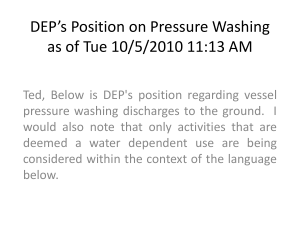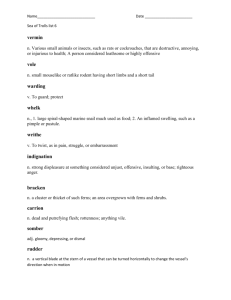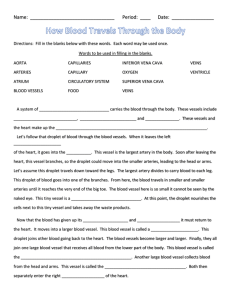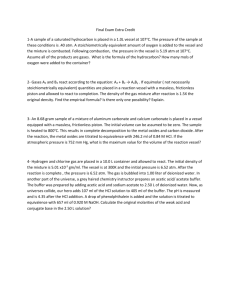GUNS
advertisement
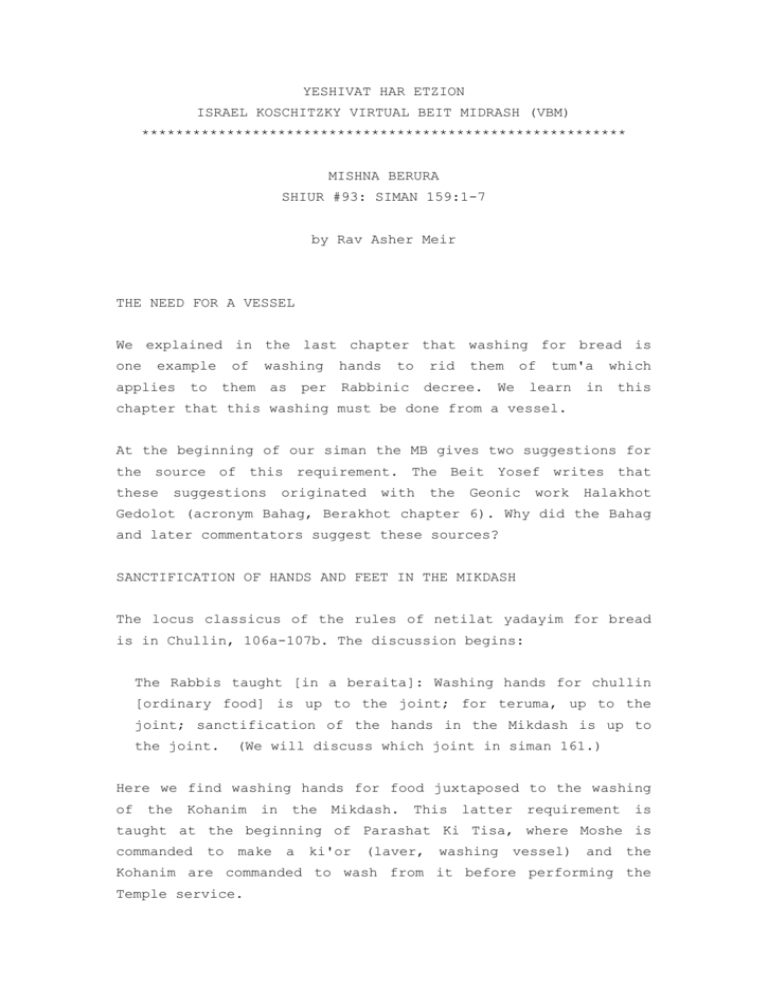
YESHIVAT HAR ETZION ISRAEL KOSCHITZKY VIRTUAL BEIT MIDRASH (VBM) ********************************************************* MISHNA BERURA SHIUR #93: SIMAN 159:1-7 by Rav Asher Meir THE NEED FOR A VESSEL We explained in the last chapter that washing for bread is one example applies to of washing them as per hands to Rabbinic rid them decree. of We tum'a learn in which this chapter that this washing must be done from a vessel. At the beginning of our siman the MB gives two suggestions for the source of this requirement. The Beit Yosef writes that these suggestions originated with the Geonic work Halakhot Gedolot (acronym Bahag, Berakhot chapter 6). Why did the Bahag and later commentators suggest these sources? SANCTIFICATION OF HANDS AND FEET IN THE MIKDASH The locus classicus of the rules of netilat yadayim for bread is in Chullin, 106a-107b. The discussion begins: The Rabbis taught [in a beraita]: Washing hands for chullin [ordinary food] is up to the joint; for teruma, up to the joint; sanctification of the hands in the Mikdash is up to the joint. (We will discuss which joint in siman 161.) Here we find washing hands for food juxtaposed to the washing of the Kohanim in the Mikdash. This latter requirement is taught at the beginning of Parashat Ki Tisa, where Moshe is commanded to make a ki'or (laver, washing vessel) and the Kohanim are commanded to wash from it before performing the Temple service. The Tosefta of Tractate Yadayim, discussed last shiur, which discusses the rules of purification of hands from the Rabbinical tum'a, makes the same comparison. The first tosefta of the second chapter tells us that the washing of the Kohanim in the Mikdash is "up to the joint." This may suggest a connection to washing for food. PREPARING MEI CHATAT FROM THE RED HEIFER A different impression is given from the Mishna in Yadayim. The second mishna of the tractate reads: Water can be poured on the hands from any vessel, even dung vessels, stone vessels or earthen vessels. Water may not be poured onto the hands from the sides of the vessel nor from the lip of the ladle, and one can not pour for his fellow from his cupped hands, because filling and sanctification and sprinkling of mei chatat, and pouring on hands, can be done only from a vessel (Mishna Yadayim 1:2). "Mei chatat" refers to the special mixture of water mixed with ashes from the red heifer, which is sprinkled on a temei met as part of the purification process. The water is put into a vessel (filling), mixed with the ashes (sanctification), and sprinkled on the tamei (sprinkling). The requirement for a vessel for mei chatat is explicit in the Torah: "And the ash of the burning of the chatat shall be taken, and on it put living waters INTO A VESSEL." From the words "into a vessel," as opposed to the shorter equivalent "in a vessel," the Sifri infers that any vessel is adequate, not only those which are considered proper for the purpose of tum'a and tahara. The mishna just cited actually begins by explaining that "all vessels are fit for washing hands," a formulation which a connection to mei chatat, exactly as the SA does in the beginning of our siman. This parallel is strengthened by its wording which is almost identical to that of the mishna in Tracate Para itself, chapter 5:5 (Tracate Para is dedicated to the rules of the "para aduma," or red heifer). Indeed, R' Shimshon of Sens in his commentary on Yadayim wonders why the mishna in Para doesn't mention the parallel to netilat yadayim as the mishna in Yadayim mentions the parallel to the mei chatat. The Behag and the MB mention these very parallels. It seems that in both cases the need for a vessel accentuates the ACT of purification. The element of human intervention not the result of water-cleansed hands, appears to be the crucial element. The fact that the water needs to be collected in a vessel of human construction ensures this element. This stands in opposition to the case of a mikveh where the halakhic requirement is for an ABSENCE of human intervention, which makes the water "sheuvin" (drawn). The mishna enumerates these same types of vessels as among those which DISQUALIFY the mikveh water (Mikvaot 4:1). We will see later in the shiur that the hands can be immersed in a mikveh or spring. But if the water has been detached by human action, then further human action is necessary to enable it to purify. DEFINITION OF A VESSEL Even though we have just explained that the definition of a "vessel" for the purposes of washing is broader than for the purposes of tum'a and tahara, many details remain dependent on the tum'a-and-tahara based definitions. Here we will give a brief introduction. Tum'a is relevant to people, food, and keilim (utensils). Raw materials (rocks, twigs, etc.) are not susceptible to tum'a at all. Even objects of use can become tamei only when they are intentionally adapted for some purpose. Conversely, when a utensil becomes so damaged that it loses its usefulness, it also loses its ability to become tamei. If it is ALREADY tamei, it becomes tahor when broken. This is implied in the Torah itself, which explains that clay vessels can not be purified by standard means, rather require breakage. (Vayikra 6:21, 11:33, 15:12). There is no mitzva to break tamei vessels; rather, this is the Torah's way of purifying these vessels. The halakha provides specific guidelines as to how "broken" each kind of vessel must be in order to be rendered an exvessel. For example, large containers of wood or bone are nullified by a hole "ke-motzi rimon" (the size of a pomegranate, Rambam Kelim 6:2), smaller containers and clay vessels by a hole "ke-motzi zayit" (the size of an olive -ibid 6:5) and clay vessels intended to hold liquid by an opening which is "koness mashkin," (which allows liquid to seep out, ibid 18:1). This introduction should make it possible to understand the Bi'ur Halakha d.h. "batel" and MB s.k. 10 which assume familiarity with these concepts. KOACH NOTEN - SE'IF 7 IN THE SA After we have learned about the necessity for a vessel, we learn in se'if 7 that a vessel may not be essential after all. The source for this halakha is in the following passage: Rav Pappa said: An irrigation channel [which is filled by pouring from buckets] may not be used for netilat yadayim, because [the water] does not come from human effort. However, if one is close to the person pouring, so that the water DOES come from human effort, it can be used for netilat yadayim (Chullin 107a). If one is close to the water drawer, then it is as if the drawer himself pours the water from the bucket onto the hands, which is a perfectly kosher netilat yadayim. But if the water is further down the pipe, then the human effort is no longer evident, and the netila is not valid. The Tosafot point out that the Tannaim dispute whether hand washing requires human effort (Yadayim 1:5). Most Rishonim rule in accordance with Rebbe Yosi who requires human effort. The Behag rules like Tanna Kamma that it is not, and that the hands may be immersed in an ordinary container of water for "netilat yatayim," which seems to run counter to R' Pappa's ruling. Some resolve this by pointing out that the channel is not itself a container. If it were, Rav Pappa would permit washing from it even though the force of the drawer has dissipated. Another solution immersion in is drawn that water the in a Tanna Kamma container would and validate immersion in spring water in a spring, but not immersion in drawn water in a spring. In this latter case, we lack the element of natural purification provided by spring water, and we lack the element of human intervention provided by filling up a vessel (Tosafot and Ramban respectively, cited by the Bach). THERE'S A HOLE IN THE BUCKET The SA rules surprising leniently if the bucket has a leak. The source is the continuation of the passage just discussed: And if the bucket is split so as to allow water to come in, then there is an attachment, and the hands can [even be] immersed [in the channel]. An "attachment" means that the channel is considered part of the river itself, since there is a continuous flow of water from the channel to the bucket as water pours out, and thence from the bucket to the river as water leaks back out of the fissure. This is what the SA means when he writes that for this purpose "nitzok mechaber" - mere pouring - is considered an actual union. A PUMP OR A FAUCET In s.k. 47 the MB discusses washing from a "plomp" - a well pump. He concludes that this is possible only when the flow from the pump may be considered as coming directly from the well. It is not considered a valid netila by virtue of the fact that the act of pumping is human effort, since the water is not coming from a vessel. Netila can be done with human effort from a vessel, and tevila with connection to a spring or mikveh without a vessel, but not by netila without a vessel. This brings us to the question whether the household plumbing we are used to is considered a "vessel." If it is, then it is possible to wash for bread merely by repeatedly opening up the faucet. Releasing the water in this way is an instance of human effort (as we will learn in se'if 9), and if the plumbing is considered a "kli" then this kind of washing is sufficient. This question is discussed by several contemporary authorities. The Tzitz Eliezer (XIII:7) at first sees little problem with such washing. Firstly, he reasons that the pipe or hose is itself a "vessel." After all, as long as the faucet is closed it holds water. Secondly, the water is stored on the roof in a big barrel, and the entire pipe or hose is like one long faucet. This is exactly the case discussed by the Rema in the end of our se'if! However, he concludes that while this reasoning can be relied upon in need, there is room for doubt. Very often the pipes are FIRST attached to the structure and only AFTERWARDS attached to the faucet, making it a vessel. This corresponds to the FIRST situation discussed by the Rema, which he disqualifies. Furthermore, this very order of arranging the plumbing suggests that the pipes or hoses have an independent importance separate from the barrel, and is therefore very different from a longish tap. We may add that today it is relatively unusual to store cold water in a container on top of the house - even in Israel. This suggests that if it is necessary to resort to washing straight from the faucet through repeatedly opening the tap, it would be prudent to open only the HOT water tap, since hot water is usually stored in a separate boiler.


